Portal:Radiation astronomy/X-ray astronomy article

X-ray astronomy by sounding rocket uses a sounding rocket to carry an X-ray detector to high altitudes. The first evidence of X-rays from the Sun and of an X-radiation source from the Milky Way, other than the Sun, was detected by a sounding rocket. These rockets have contributed significantly to our understanding of the Sun, the solar system, and the universe as a whole.
In astronomy, the interstellar medium (or ISM) is the gas and dust that pervade interstellar space: the matter that exists between the star systems within a galaxy. It fills interstellar space and blends smoothly into the surrounding intergalactic space. The interstellar medium consists of an extremely dilute (by terrestrial standards) mixture of ions, atoms, molecules, larger dust grains, cosmic rays, and (galactic) magnetic fields. The energy that occupies the same volume, in the form of electromagnetic radiation, is the interstellar radiation field.
Of interest is the hot ionized medium (HIM) consisting of coronal gas at 106-107 K which emits X-rays. The ISM is turbulent and therefore full of structure on all spatial scales. Stars are born deep inside large complexes of molecular clouds, typically a few parsecs in size. During their lives and deaths, stars interact physically with the ISM. Stellar winds from young clusters of stars (often with giant or supergiant HII regions surrounding them) and shock waves created by supernovae inject enormous amounts of energy into their surroundings, which leads to hypersonic turbulence. The resultant structures – of varying sizes – can be observed, such as stellar wind bubbles and superbubbles of hot gas, seen by X-ray satellite telescopes. The Sun is currently traveling through the Local Interstellar Cloud, a denser region in the low-density Local Bubble.

Within the constellations Orion and Eridanus and stretching across them is a soft X-ray "hot spot" known as the Orion-Eridanus Superbubble, the Eridanus Soft X-ray Enhancement, or simply the Eridanus Bubble, a 25° area of interlocking arcs of Hα emitting filaments.
Soft X-rays are emitted by hot gas (T ~ 2-3 MK) in the interior of the superbubble. This bright object forms the background for the "shadow" of a filament of gas and dust. The filament is shown by the overlaid contours, which represent 100 micrometre emission from dust at a temperature of about 30 K as measured by IRAS. Here the filament absorbs soft X-rays between 100 and 300 eV, indicating that the hot gas is located behind the filament. This filament may be part of a shell of neutral gas that surrounds the hot bubble. Its interior is energized by UV light and stellar winds from hot stars in the Orion OB1 association. These stars energize a superbubble about 1200 lys across which is observed in the optical (Hα) and X-ray portions of the spectrum.
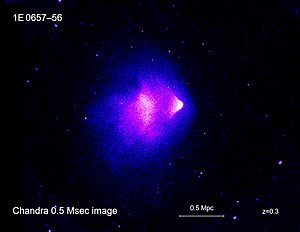
An astrophysical X-ray source is an astronomical object with physical properties which result in the emission of X-rays.
There are a number of types of astrophysical objects which emit X-rays, from galaxy clusters, through black holes in active galactic nuclei (AGN) to galactic objects such as supernova remnants, stars, and binary stars containing a white dwarf (cataclysmic variable stars and super soft X-ray sources), neutron star or black hole (X-ray binaries). Some solar system bodies emit X-rays, the most notable being the Moon, although most of the X-ray brightness of the Moon arises from reflected solar X-rays.
Clusters of galaxies are formed by the merger of smaller units of matter, such as galaxy groups or individual galaxies. The infalling material (which contains galaxies, gas and dark matter) gains kinetic energy as it falls into the cluster's gravitational potential well. The infalling gas collides with gas already in the cluster and is shock heated to between 107 and 108 K depending on the size of the cluster. This very hot gas emits X-rays by thermal bremsstrahlung emission, and spectral line emission from metals (in astronomy, 'metals' often means all elements except hydrogen and helium). The galaxies and dark matter are collisionless and quickly become virialised, orbiting in the cluster potential well.


One of the recent balloon-borne experiments was called the High-resolution gamma-ray and hard X-ray spectrometer (HIREGS). It was first launched from McMurdo Station, Antarctica, in December 1991, when steady winds carried the balloon on a circumpolar flight lasting for about two weeks.
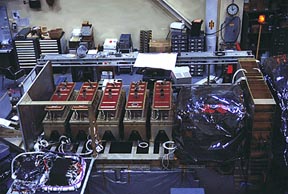
X-ray astronomy detectors have been designed and configured primarily for energy and occasionally for wave-length detection using a variety of techniques usually limited to the technology of the time.
X-ray detectors collect individual X-rays (photons of X-ray electromagnetic radiation) including the number of photons collected (intensity), the energy (0.12 to 120 keV) of the photons collected, wavelength (~0.008 to 8 nm), or how fast the photons are detected (counts per hour), to tell us about the object that is emitting them.

Solar X-ray astronomy is a branch of X-ray astronomy which focuses on understanding the origin of X-ray emission from the Sun. Most of our current knowledge of the Sun comes from observing it in the visual portion of the electromagnetic spectrum. However, when observed with appropriate instruments in the X-radiation portion of this spectrum the Sun is almost a variable star, and at times almost a dark star.
GOES 14 was launched into orbit on June 27, 2009 at 22:51 GMT from Space Launch Complex 37B at the Cape Canaveral Air Force Station. GOES 14 is a more recent satellite to be launched with X-ray detection capability currently in operation. The importance of X-ray astronomy is exemplified in the use of an X-ray imager such as the one on GOES 14 for the early detection of solar flares, CMEs and other X-ray generating phenomena that impact the Earth.

Stellar surface fusion is one of the few direct views physicists have of thermonuclear fusion. Nuclear fusion usually occurs within a star as a part of stellar nucleosynthesis. However, an accreting star can undergo surface nuclear burning when the accretion rate exceeds a certain limit. The stellar luminosity then becomes dominated by hydrogen burning. The energy liberated by hydrogen burning exceeds that due to accretion by an order of magnitude or more, depending on the mass of the star. Steady hydrogen burning on the stellar surface processes hydrogen into helium at the rate of accretion. Surface fusion occurs above a star's photosphere to a limited extent as found in studies of near coronal and corona activity.
Based on the 3He-flare flux from the Sun's surface and Surveyor 3 samples (implanted 15N and 14C in lunar material) from the surface of the Moon, the level of nuclear fusion occurring in the solar atmosphere is approximately at least two to three orders of magnitude greater than that estimated from solar flares such as those of August 1972.

Stellar X-ray astronomy started on April 5, 1974, with the detection of X-rays from Capella. A rocket flight on that date briefly calibrated its attitude control system when a star sensor pointed the payload axis at Capella (α Aur). During this period, X-rays in the range 0.2-1.6 keV were detected by an X-ray reflector system co-aligned with the star sensor. Since that event a large number of stars have been studied using their X-radiation emission.
Three structures around Eta Carinae are thought to represent shock waves produced by matter rushing away from the superstar at supersonic speeds. The temperature of the shock-heated gas ranges from 60 MK in the central regions to 3 MK on the horseshoe-shaped outer structure. "The Chandra image contains some puzzles for existing ideas of how a star can produce such hot and intense X-rays," says Prof. Kris Davidson of the University of Minnesota. Davidson is principal investigator for the Eta Carina observations by Hubble. "In the most popular theory, X-rays are made by colliding gas streams from two stars so close together that they'd look like a point source to us. But what happens to gas streams that escape to farther distances? The extended hot stuff in the middle of the new image gives demanding new conditions for any theory to meet."

An X-ray telescope (XRT) is a telescope that is designed to observe remote objects in the X-ray spectrum. In order to get above the Earth's atmosphere, which is opaque to X-rays, XRTs must be mounted on high altitude rockets or artificial satellites. The telescopes have varying directionality or imaging ability based on glancing angle reflection rather than refraction or large deviation reflection. The most common methods of design are grazing incidence mirrors and coded apertures. The limitations of X-ray optics result in much narrower fields of view than visible or UV telescopes. A recent innovation in telescope design uses normal incidence reflective multilayer optics.

X-ray astronomy satellites study X-ray emissions from celestial objects. Satellites, which can detect and transmit data about the X-ray emissions are deployed as part of branch of space science known as X-ray astronomy. Satellites are needed because X-radiation is absorbed by the Earth's atmosphere, so instruments to detect X-rays must be taken to high altitude by balloons, sounding rockets, and satellites.
Those in use today include the XMM-Newton observatory (low to mid energy X-rays 0.1-15 keV) and the INTEGRAL satellite (high energy X-rays 15-60 keV). Both were launched by the European Space Agency. NASA has launched the Rossi X-ray Timing Explorer (RXTE), the Swift, and Chandra observatories. One of the instruments on Swift is the Swift X-Ray Telescope (XRT).
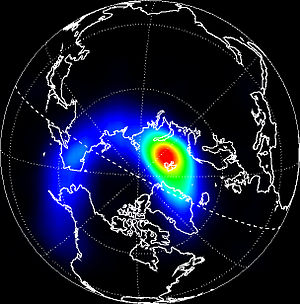
X-ray generation is producing X-radiation by a variety of phenomena. For example, when high-energy X-rays, gamma-rays, electrons, or protons bombard materials, the excited atoms within emit characteristic "secondary" (or fluorescent) X-rays. Alternately, whenever charged particles pass within certain distances of each other without being in fixed orbits, the accelerations (or decelerations) can give off X-rays.
Ultraluminous X-ray sources (ULXs) are pointlike, nonnuclear X-ray sources with luminosities above the Eddington limit of 3 × 1039 ergs s−1 for a 20 M☉ black hole.
Many ULXs show strong variability and may be black hole binaries. To fall into the class of intermediate-mass black holes (IMBHs), their luminosities, thermal disk emissions, variation timescales, and surrounding emission-line nebulae must suggest this. However, when the emission is beamed or exceeds the Eddington limit, the ULX may be a stellar-mass black hole. The nearby spiral galaxy NGC 1313 has two compact ULXs, X-1 and X-2. For X-1 the X-ray luminosity increases to a maximum of 3 × 1040 ergs s−1, exceeding the Eddington limit, and enters a steep power-law state at high luminosities more indicative of a stellar-mass black hole, whereas X-2 has the opposite behavior and appears to be in the hard X-ray state of an IMBH.

Normally, observational astronomy is performed on Earth's surface, beneath it in neutrino astronomy, or in orbit. An observer becomes a deep space explorer upon escaping Earth's orbit. For a satellite or space probe to qualify as a deep space X-ray astronomer/explorer or "astronobot"/explorer, all it needs to carry aboard is an X-ray telescope or X-ray detector and leave the cozy confines of Earth orbit. Its discoveries and adventures become a part of Explorational X-ray astronomy.

In 1927, E.O. Hulburt of the US Naval Research Laboratory and associates Gregory Breit and Merle Tuve of the Carnegie Institution of Washington explored the possibility of equipping Robert H. Goddard's rockets to explore the upper atmosphere. "Two years later, he proposed an experimental program in which a rocket might be instrumented to explore the upper atmosphere, including detection of ultraviolet radiation and X-rays at high altitudes." This became a part of the History of X-ray astronomy.

There are 88 official constellations that the International Astronomical Union (IAU) has used to divide the celestial sphere into 89 irregularly shaped boxes. The constellation Serpens is split into two separate sections, Serpens Caput (the snake's head) to the west and Serpens Cauda (the snake's tail) to the east. Using detectors placed above the Earth's atmosphere, X-radiation has been detected as incoming from each of these constellational areas. Searching for the first X-ray source per constellation is a history of science exercise that is still ongoing as the initial X-ray source for many of the constellations is questionable or unknown.
Compare the Chandra X-ray Observatory X-ray image with the Hubble Space Telescope visual image. Sirius A is spectral type A1V, whereas Sirius B is a white dwarf of type DA2.
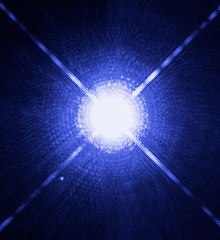

With the initial detection of an extrasolar X-ray source, the first question usually asked is "What is the source?" An extensive search, such as from a list of stars by constellation, is often made in other wavelengths such as visible or radio for possible coincident objects. But, there are inherent difficulties in making X-ray/optical, X-ray/radio, and X-ray/X-ray identifications based solely on positional coincidents, especially with handicaps in making identifications, such as the large uncertainties in positional determinants made from balloons and rockets, poor source separation in the crowded region toward the galactic center, source variability, and the multiplicity of source nomenclature.
Extrasolar X-ray source astrometry is a branch of astrometry that focuses on discriminating X-ray sources and determining their positions accurately.

An X-ray binary is a class of binary star that is luminous in X-rays.
The X-rays are produced by matter falling from one component, called the donor (usually a relatively normal star) to the other component, called the accretor, which is compact: a white dwarf, neutron star, or black hole. The infalling matter releases gravitational potential energy, up to several tenths of its rest mass, as X-rays. (Hydrogen fusion releases only about 0.7 percent of rest mass.)

Not only are there apparently X-ray dark stars, but planets generally are not usually capable of X-ray luminescence. X-ray observations offer the possibility to detect X-ray dark planets as they eclipse part of the corona of their parent star while in transit. "Such methods are particularly promising for low-mass stars as a Jupiter-like planet could eclipse a rather significant coronal area."
As X-ray detectors have become more sensitive, they have observed that some planets and other normally X-ray non-luminescent celestial objects under certain conditions emit, fluoresce, or reflect X-rays.
Jupiter's strong, rapidly rotating magnetic field (light blue lines in the figure) generates strong electric fields in the space around the planet. Charged particles (white dots), trapped in Jupiter's magnetic field, are continually being accelerated (gold particles) down into the atmosphere above the polar regions, so auroras are almost always active on Jupiter. Electric voltages of about 10 megavolts, and currents of 10 megaamperes—a hundred times greater than the most powerful lightning bolts—are required to explain the auroras at Jupiter's poles, which are a thousand times more powerful than those on Earth.

"In 1572, the Danish astronomer Tycho Brahe observed and studied the explosion of a star [in Cassiopeia, at about 13,000 light years, RA 00h 25m 17s | Dec +64° 08' 37] that became known as Tycho's supernova. More than four centuries later, Chandra's image of the supernova remnant shows an expanding bubble of multimillion degree debris (green and red) inside a more rapidly moving shell of extremely high energy electrons (filamentary blue) [Red 0.95-1.26 keV, Green 1.63-2.26 keV, Blue 4.1-6.1 keV]."[1]
"The supersonic expansion (about six million miles per hour) of the stellar debris has created two X-ray emitting shock waves - one moving outward into the interstellar gas, and another moving back into the debris. These shock waves produce sudden, large changes in pressure and temperature, like an extreme version of sonic booms produced by the supersonic motion of airplanes."[1]
The "stellar debris has kept pace with the outer shock and is only about half a light year behind."[1]
A "large fraction of the energy of the outward-moving shock wave is going into the acceleration of atomic nuclei to speeds approaching the speed of light. The Chandra observations provide the strongest evidence yet that nuclei are indeed accelerated and that the energy contained in the high-speed nuclei in Tycho's remnant is about 100 times that observed in high-speed electrons."[1]
"Since their discovery in the early years of the 20th century, many sources of cosmic rays have been proposed, including flares on the sun and similar events on other stars, pulsars, black hole accretion disks, and the prime suspect - supernova shock waves. Chandra's observations of Tycho's supernova remnant strengthen the case for this explanation."[1]
SN 185 was a supernova which appeared in the year 185, near the direction of Alpha Centauri, between the constellations Circinus and Centaurus, centered at Right ascension (RA) 14h 43m Declination (Dec) -62° 30', in Circinus. This "guest star" was observed by Chinese astronomers in the Book of Later Han.
On the right is a "combined image from the Chandra and XMM-Newton X-ray observatories of RCW 86 [in the constellation Circinus showing] the expanding ring of debris that was created after a massive star in the Milky Way collapsed onto itself and exploded. Both the Chandra and XMM images show low energy X-rays in red, medium energies in green and high energies in blue. The Chandra observations focused on the northeast (left-hand) side of RCW 86, and show that X-ray radiation is produced both by high-energy electrons accelerated in a magnetic field (blue) as well as heat from the blast itself (red)."[2]
"Properties of the shell in the Chandra image, along with the remnant's size and a basic understanding of how supernovas expand, were used to help determine the age of RCW 86. The new data revealed that RCW 86 was created by a star that exploded about 2,000 years ago. This age matches observations of a new bright star by Chinese astronomers in 185 A.D. (and possibly Romans as well) and may be the oldest known recordings of a supernova. Supernova explosions in galaxies like ours are rare, and none have been recorded in hundreds of years."[2]

SCP 06F6 is (or was) an astronomical object of unknown type, discovered on February 21, 2006, in the constellation Boötes during a survey of galaxy cluster CL 1432.5+3332.8 with the Hubble Space Telescope's Advanced Camera for Surveys Wide Field Channel. The European X-ray satellite XMM Newton made an observation in early August 2006 which appears to show an X-ray glow around SCP 06F6, two orders of magnitude more luminous than that of supernovae.
X-ray emission occurs from many celestial objects. These emissions can have a pattern, occur intermittently, or as a transient astronomical event. In X-ray astronomy many sources have been discovered by placing an X-ray detector above the Earth's atmosphere. Often, the first X-ray source discovered in many constellations is an X-ray transient.
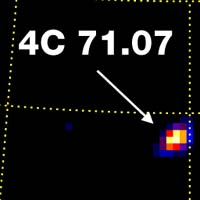

A quasi-stellar radio source (quasar) is a very energetic and distant galaxy with an active galactic nucleus (AGN). QSO 0836+7107 is a Quasi-Stellar Object that emits baffling amounts of radio energy. The radio signal is caused by electrons spiraling along the magnetic fields. These electrons can also interact with visible light emitted by the disk around the AGN or the black hole at its center, and that pumps them to emit X- and gamma-radiation.
On board the Compton Gamma Ray Observatory (CGRO) is the Burst and Transient Source Experiment (BATSE) which detects in the 20 keV to 8 MeV range. QSO 0836+7107 or 4C 71.07 was detected by BATSE as a source of soft gamma rays and hard X-rays. "What BATSE has discovered is that it can be a soft gamma-ray source". QSO 0836+7107 is the faintest and most distant object to be observed in soft gamma rays. It has already been observed in gamma rays by the Energetic Gamma Ray Experiment Telescope (EGRET) also aboard the Compton Gamma Ray Observatory.

With no strong central nuclear energy source, the interior of a brown dwarf is in a rapid boiling, or convective state. When combined with the rapid rotation that most brown dwarfs exhibit, convection sets up conditions for the development of a strong, tangled magnetic field near the surface. The flare observed by Chandra X-ray Observatory from LP 944-20 could have its origin in the turbulent magnetized hot material beneath the brown dwarf's surface. A sub-surface flare could conduct heat to the atmosphere, allowing electric currents to flow and produce an X-ray flare, like a stroke of lightning. The absence of X-rays from LP 944-20 during the non flaring period is also a significant result. It sets the lowest observational limit on steady X-ray power produced by a brown dwarf star, and shows that coronas cease to exist as the surface temperature of a brown dwarf cools below about 2500°C and becomes electrically neutral.
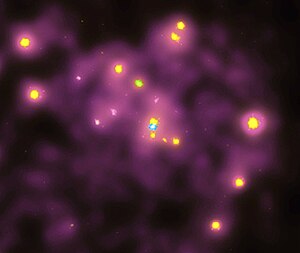
Multiple X-ray sources have been detected in the Andromeda Galaxy, using observations from the European Space Agency XMM-Newton orbiting observatory.
Like the Milky Way, Andromeda's galactic center appears to harbor an X-ray source characteristic of a black hole of a million or more solar masses. Seen above, the false-color X-ray picture shows a number of X-ray sources, likely X-ray binary stars, within Andromeda's central region as yellowish dots. The blue source located right at the galaxy's center is coincident with the position of the suspected massive black hole. While the X-rays are produced as material falls into the black hole and heats up, estimates from the X-ray data show Andromeda's central source to be very cold - only about million degrees, compared to the tens of millions of degrees indicated for Andromeda's X-ray binaries.
DEM L316 in the Large Magellanic Cloud consists of two supernove remnants. Chandra X-ray Observatory X-ray spectra show that the hot gas shell on the upper left contains a high abundance of iron. This implies that the upper left Supernova remnant (SNR) is the product of a Type Ia supernova. The much lower iron abundance in the lower SNR indicates a Type II supernova.
The Large Magellanic Cloud (LMC) is in the constellations Mensa and Dorado. LMC X-1 (the first X-ray source in the LMC) is at Right ascension (RA) 05h 40m 05s Declination (Dec) -69° 45' 51", and is a high mass X-ray binary source (HMXB).
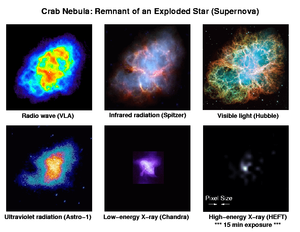
Taurus XR-1 was discovered on April 29, 1963 at J1950 Right ascension (RA) 05h 31.5m Declination (Dec) +22°. An Aerobee sounding rocket carried a proportional counter fabricated by a team from the US Naval Research Laboratory. This experiment was the first to detect X-rays from the Crab Nebula supernova remnant (SNR).
SN 1054 is the supernova that produced the Crab Nebula. Because of its steady production of X-rays, the Crab X-ray source is often used as an X-ray emission standard.

Cygnus X-1 (abbreviated Cyg X-1) is a well known galactic X-ray source in the constellation Cygnus. Cygnus X-1 was the first X-ray source widely accepted to be a black hole candidate and it remains among the most studied astronomical objects in its class. It is now estimated to have a mass about 8.7 times the mass of the Sun and has been shown to be too compact to be any known kind of normal star or other likely object besides a black hole.

Cassiopeia A (Cas A) is a supernova remnant in the constellation Cassiopeia. In 1999, the Chandra X-Ray Observatory found a "hot point-like source" close to the center of the nebula that is quite likely a neutron star or black hole.
In the image on the right, red is infrared data from the Spitzer Space Telescope, orange is visible data from the Hubble Space Telescope, and blue and green are data from the Chandra X-ray Observatory. The cyan dot just off-center is the remnant of the star's core.
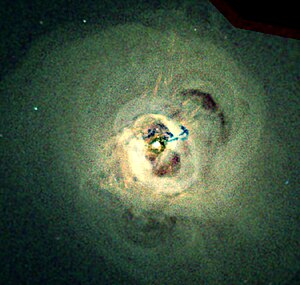
The Perseus Cluster (Abell 426) is a cluster of galaxies in the constellation Perseus. It is one of the most massive objects in the universe, containing thousands of galaxies immersed in a vast cloud of multimillion degree gas.
The detection of X-ray emission from Perseus XR-1 occurred during an Aerobee rocket flight on March 1, 1970. The source may have been associated with NGC 1275 (Per A, 3C 84), and was reported in 1971. More detailed observations from Uhuru confirmed the earlier detection and associated the source with the Perseus cluster.
The image on the right is 284 arcsec across. Right ascension (RA) 03h 19m 47.60s Declination (Dec) +41° 30' 37.00" in Perseus. Observation dates: 13 pointings between August 8, 2002 and October 20, 2004. Color code: Energy (Red 0.3-1.2 keV, Green 1.2-2 keV, Blue 2-7 keV). Instrument: ACIS.
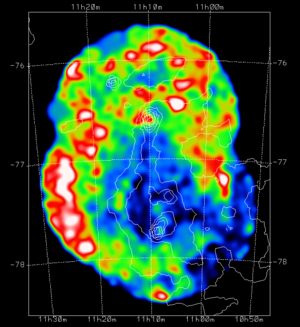
The Chamaeleon complex is a large star forming region (SFR) that includes the Chamaeleon I, Chamaeleon II, and Chamaeleon III dark clouds. It occupies nearly all of the constellation Chamaeleon and overlaps into Apus, Musca, and Carina.
In the image on the right, the contours are 100 µm emission from dust measured by the IRAS satellite.

From the Chandra X-ray Observatory analysis of the Antennae Galaxies rich deposits of neon, magnesium, and silicon were discovered. These elements are among those that form the building blocks for habitable planets. The clouds imaged contain magnesium and silicon at 16 and 24 times respectively, the abundance in the Sun.
The Antennae Galaxies (also known as NGC 4038/NGC 4039) are a pair of interacting galaxies in the constellation Corvus.
Nominating or creating articles
If you have a suggestion for future Selected articles for this portal, please suggest them on the discussion page, or create them yourself. You can also suggest future Selected pictures at Portal talk:X-ray astronomy/Picture. If you have any questions, contact User:Marshallsumter or leave a message at WikiProject Astronomy.
- ↑ 1.0 1.1 1.2 1.3 1.4 J. Warren & J. Hughes (29 April 2003). Tycho's Supernova Remnant: Tycho's Remnant Provides Shocking Evidence for Cosmic Rays. Cambridge, Massachusetts, USA: Harvard-Smithsonian Center for Astrophysics. http://chandra.harvard.edu/photo/2005/tycho/. Retrieved 2016-12-02.
- ↑ 2.0 2.1 J. Vink (15 June 2004). RCW 86: New Evidence Links Stellar Remains to Oldest Recorded Supernova. Cambridge, Massachusetts, USA: Harvard-Smithsonian Center for Astrophysics. http://chandra.harvard.edu/photo/2006/rcw86/. Retrieved 2016-02-12.